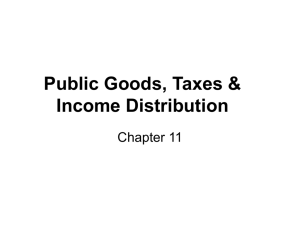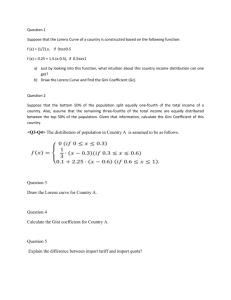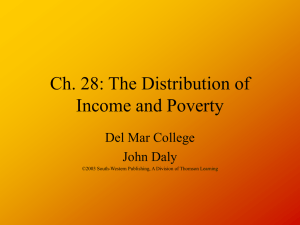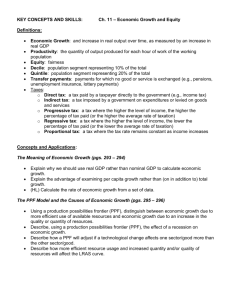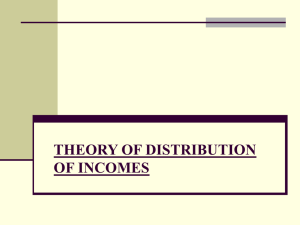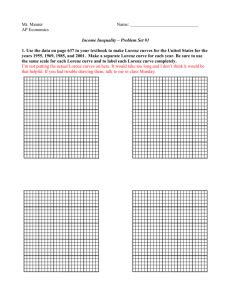Equity in the distribution of income
advertisement
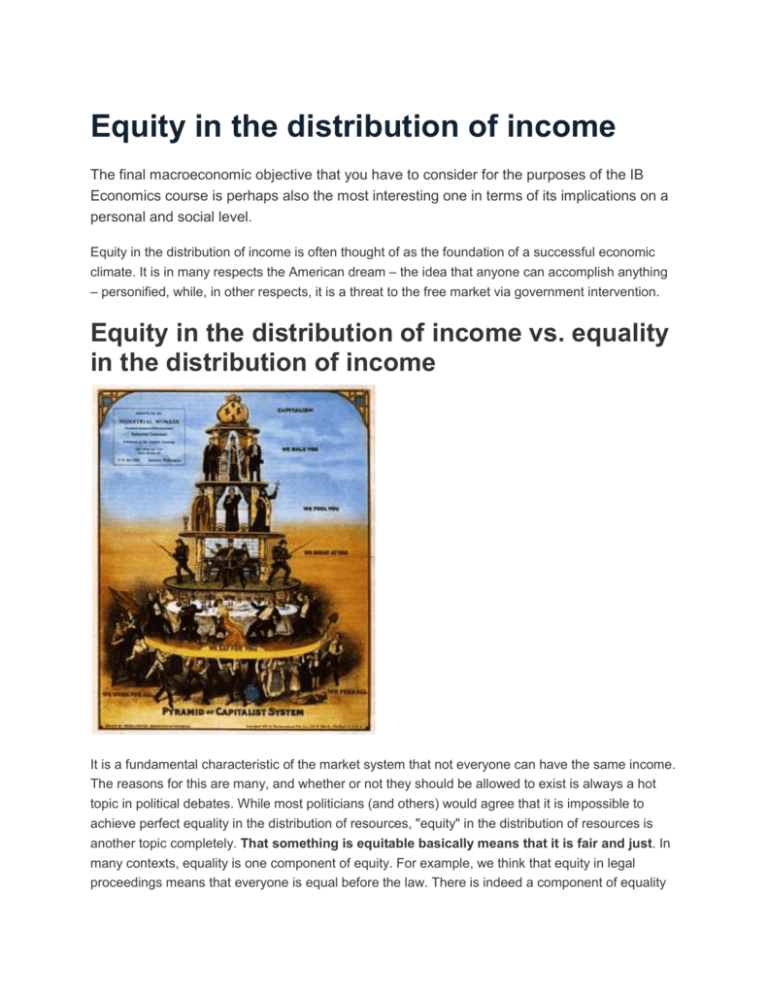
Equity in the distribution of income The final macroeconomic objective that you have to consider for the purposes of the IB Economics course is perhaps also the most interesting one in terms of its implications on a personal and social level. Equity in the distribution of income is often thought of as the foundation of a successful economic climate. It is in many respects the American dream – the idea that anyone can accomplish anything – personified, while, in other respects, it is a threat to the free market via government intervention. Equity in the distribution of income vs. equality in the distribution of income It is a fundamental characteristic of the market system that not everyone can have the same income. The reasons for this are many, and whether or not they should be allowed to exist is always a hot topic in political debates. While most politicians (and others) would agree that it is impossible to achieve perfect equality in the distribution of resources, "equity" in the distribution of resources is another topic completely. That something is equitable basically means that it is fair and just. In many contexts, equality is one component of equity. For example, we think that equity in legal proceedings means that everyone is equal before the law. There is indeed a component of equality also in the equitable distribution of income, but not so much in relation to the actual distribution as with the opportunity of achieving a certain income. Equity in the distribution of income means that everyone has the same opportunities to compete for income, regardless of age, gender, social background or any other personal or cultural characteristic. It is a statement of fact that the distribution of income in many countries is not only unequal, but also inherently inequitable. Children can be born into poverty, and because they have no chance of receiving an appropriate education, they will be "locked" into poverty throughout their lives. Even in countries like Sweden, Norway and Finland, where state schools are of a high quality and education is free, it would be wrong to say that there is perfect equity in the distribution of resources. While some children are born into a safe and stable environment with a loving family supporting them, others have to combat cultural and language barriers, parents with drug problems and unhelpful teachers. In more economic terms, we might say that an unequal ownership of the factors of production may lead to inequitable distribution of income. If land, traditionally regarded as the most important factor of production, is passed down from generation to generation in one family, members of the family will undoubtedly have an advantage in producing output compared to individuals who do not have any land. Still, the possibility of inheriting one’s parents and grandparents is certainly not inequitable, and neither is owning factors of production. The inequity lies in the non-existence of any real chance of acquiring factors of production because of the way society is structured. The Lorenz curve and the Gini coefficient The Lorenz curve and the Gini coefficient are ways of expressing the income equality of a country. They are useful both in terms of giving an actual illustration or number indicating something that is otherwise difficult to grasp, and in terms of providing a tool for comparing different countries. The Lorenz curve When constructing a Lorenz curve, households in the country are ranked in ascending level of income as a percentage of total income in the country. For example, you look at how large a percentage of the total income is earned by the poorest 10 per cent of households, then the poorest 20 per cent etc in ascending order. The Lorenz curve illustrates this data, and, for comparison, a line of perfect distribution is added. These are both plotted in the diagram below. As can be seen in the diagram, the Lorenz curve illustrates the actual distribution of income in a country. The line of perfect distribution on the other hand illustrates a perfectly equal distribution. Any point on the Lorenz curve gives you a certain percentage of the total population on the x-axis, and a corresponding percentage of the total income that they receive. In the diagram above, we can see that the poorest 40% of the population receive merely 10% of the total income, while the richest 10% receive 40% of the total income. As you can probably guess, the further away the Lorenz curve is from the line of perfect distribution, the more uneven the distribution of income. The Gini coefficient The Gini-coefficient is simply a mathematical way of expressing what the Lorenz curve shows us. The Gini coefficient is calculated by dividing the shaded area in the diagram above by the whole area to the right of the line of perfect distribution. (i.e. the whole right triangle). This means that the bigger the shaded area (the bigger the "Lorenz-belly") the closer to 1 the Gini coefficient would be. This, in turn, means a Gini coefficient that is close to 1 tells us that resources are unevenly distributed. A lower Gini coefficient suggest that the Lorenz-belly is smaller, i.e. that the Lorenz curve is closer to the line of perfect distribution. A low Gini coefficient would then suggest that resource distribution is more even. Poverty Poverty refers to the situation where a person lacks material possessions and money. Poverty can be either absolute or relative. Absolute poverty refers to the situation when a person lacks sufficient resources to buy even the most basic of human needs, such as food and water. Relative poverty on the other hand is when a person lacks the resources to maintain the same standard of living as the vast majority of other people in the economy. For example, whilst absolute poverty in Sweden is almost non-existent, relative poverty, visible in terms of big families sharing small apartments, children who are unable to come to school trips, pensioners who cannot afford to stay in their homes etc. is very real. In many countries, poverty, both absolute and relative, inevitably leads to a low standard of living, and poor access to healthcare and education. Poverty can have a variety of causes, the most obvious being low income. If you do not earn enough money to buy food and pay rent, you are, by definition, in poverty. The low income can, in turn, be a result of unemployment, a low level of part-time work, or even a disability, making you unable to work. It may well also be a result of a lack of human capital. Human capital essentially refers to the competences and skills that you have gathered throughout your life that allow you to produce something of economic value. For example, in order to teach maths, you must yourself know all the necessary calculations. Many people who have grown up in poverty lack in human capital as they have never had the opportunity to attend school. The role of taxation in promoting equity Governments all over the world intervene in the distribution of income on a daily basis by levying taxes. The primary reason for doing so is unlikely to be redistribution of income per se, but it is often one of the many objectives of a government to do so, and in any case, it is a collateral effect of generating enough tax revenue to pay for various welfare services and other projects run by the state. Taxes may be divided into direct taxes and indirect taxes: Important A direct tax is a tax levied directly on a person’s income or wealth, or on the profit made by a firm. Important An indirect tax is a tax levied on consumption. In other words, the tax that is deducted from your income (or your parents’ incomes) each month is a direct tax. This is normally a percentage rate dependent on how much you earn. On the other hand, you only pay indirect taxes when you actually consume products and services. The primary example of an indirect tax is VAT, or value-added tax. This is a percentage rate added on to the value of each product. Just like direct taxes, indirect taxes on products and services vary from one country to another, and it is also common that they vary between different products and services in the same country. For example, the VAT on books is generally lower than the VAT on alcohol in an attempt by the government to influence the way that people spend their money. Direct taxes is the primary tool used by the government in order to redistribute income. By charging a percentage rate, e.g. 30 per cent of the total income earned, they make sure that people with high incomes pay a higher monetary amount than those on low incomes. Charging the same percentage rate to everyone in the population is known as proportionate taxation. In fact, many countries do however operate a so-called progressive tax rate system. Important A progressive tax system is a system where the average percentage tax rate increases as income increases. The way in which a progressive tax rate works is that the government decides on certain income bands, associated with a certain marginal tax rate. In other words, the government decides on a rate of tax that you pay on all your income within that band. Consider the table below. Income (£) Marginal tax rate: 0 - 5000 0 Income (£) Marginal tax rate: 5001 - 10000 20% 10001 - 14000 30% 14001 - 20000 35% 20001 - 30000 40% 30001+ 50% This means that a person who earns less than £5000 per year, for example a student working during his or her summer holiday would pay no income tax at all. A person who earns an income of £8000 on the other hand pays no taxes on the first £5000, but 20% in taxes on the last £3000. In other words, a person who earns £8000 would pay in taxes: £5000×0 %=£0 £3000×20 %=£600 This means that she has paid an average tax rate of: 6008000×100=7.5 % For a more advanced example, consider a person who earns £55000 per year. She also taxes according to the same marginal tax rates listed in the table above. First, we want to calculate how much taxes she pays in total. This is most easily done by breaking hear total income down into components corresponding to the respective income bands. (£5000–0)×0=0 (£10001–£5000)×20 %=£1000 (£14001–£10000)×30 %=£1200 (£20001–£14000)×35 %=£2100 (£30001–£20000)×40 %=£4000 (£55001–£30000)×50 %=£12500 If we add up the taxes paid in each income band, we get: 1000+1200+2100+4000+12500=£20800 Knowing this, we can calculate the average tax rate by dividing this number by the total income earned. This gives us a tax rate of: £20800£55000×100=37.8 % Compare this average tax rate to that paid by the low-income earner referred to above. The opposite of progressive taxation is known as regressive taxation. Important Regressive taxation is when the average tax rate levied decreases as income increases. Regressive taxation thus works in a very similar way to progressive taxation with different income bands determined by the government. However, rather than having an increasingly higher marginal tax rate, the marginal tax rate becomes lower. While this may sound strange, it should be remembered that the monetary amount paid by high income earners will still be much higher than that paid by low-income earners. In addition, one of the primary reasons why a government would wish to operate a regressive taxation system is to make high income earners settle in their country, and thus receive higher tax revenue than they otherwise would. For example, the German Formula 1 driver Michael Schumacher is a resident of Switzerland in order to avoid the higher tax rates he would have to pay in Germany. By levying a lower tax rate, the Switzerland thereby receives several million Euros in tax money than they would if Schumacher had lived in Germany. The extra money can be used to finance healthcare, education and infrastructure that benefit everyone, including those on low incomes. Indeed, the government will even make use of the extra income for the purposes of transfer payments, that is, monetary assistance to certain groups with the aim of improving their living standards directly. Such payments include unemployment benefits, child allowances and oldage pensions. The relationship between equity and equality As you will hopefully have understood from this lesson, an unequal distribution of income is inevitable in any market-based economy, and the incentive of making a profit or earning higher wages is the primary economic fuel that encourages new inventions and hard work. A very uneven distribution of income is however undesirable for many reasons. Not only does it involve some people living in relative, or perhaps even absolute poverty, it is also harmful to the economy as a whole in terms of reduced spending. Worst of all might however be the waste of talent: people who are born into poverty might become excellent doctors and engineers, might become great thinkers or make brilliant inventions, but because they are held back by their social situation, they never really have the opportunity of succeeding in these fields. In order to prevent poverty and general harm to the economy, the government engages in practices to redistribute income. Levying progressive taxes and making transfer payments as well as general investments in infrastructure will help towards a more even distribution of income. In most political systems however, this is not an end in itself. An even distribution of income is good so long as it promotes an equitable distribution of income, so long as it promotes equal opportunities. Every person should have the ability to do achieve his or her ambitions, and every person should have the ability to pursue every possible career. This is highly beneficial to the economy as a whole as it promotes the best use of talent. Taxes and transfer payments may however not be enough to achieve this. The government may need to actively intervene in order to provide education and make sure to take cultural differences into account. It must also remember that levying too high taxes will act as a disincentive in terms of stripping innovators and hard workers of their reward. It is thus a thin line that the government must balance in order to promote equity in the distribution of income. What you should know Equity in the distribution of income means that the distribution is fair and just, and is more concerned with equal opportunities rather than equality in the distribution of income. One of the most prominent causes of inequity in the distribution of income is uneven ownership of the factors of production. The Lorenz curve and the Gini coefficient are ways of expressing the equality in the distribution of income. Absolute poverty is defined as being unable to afford even the most basic of human needs, such as food and water. Relative poverty is defined as being unable to maintain the same standard of living as the vast majority in the country of residency. Taxes can be either direct or indirect. Direct taxes are taxes on income.Indirect taxes are taxes on consumption. When the marginal tax rate increases as income increases, the government operates a progressive taxation system. When the marginal tax rate decreases as income increases, the government operates a regressive taxation system.
